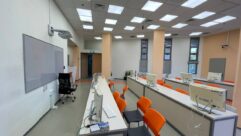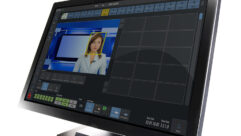
Technology Showcase: AV-control Software
Mar 1, 2007 12:00 PM,
By Bennett Liles
Software provides a vital interface for AV-control system users.

Stardraw Control
While recent developments in the crowded field of AV room-control hardware have been examined at length, these units tend to make their debut and then go into seclusion inside a rack, not to see daylight again until they either fail and are replaced or are upgraded. When manufacturers display their wares to prospective clients, it is usually the software that takes center stage, because it is the software that will remain in daily contact with users and system techs. It also performs the vital function of initial system design and configuration where the programmers’ creativity gets to shine through all the bolts, brackets, and wires.
Although the real processing power and switching action resides in that hidden control unit, it is the system’s graphical user interface (GUI) that gives the system its personality. For this reason, this article will take a software approach to IP-connected AV room-control systems, examining some common functions, as well as a few innovative and powerful features. These applications generally group into categories of system design tools, control applications, and programming accessories, but many products will (to a degree) include several of these functions.
In the software side of AV room control, the various companies involved have demonstrated at least as many different approaches as they have in their hardware. Some firms market software solutions alone, with products based on the most generic possible platform in order to work with just about any hardware. Products with this approach presently command a relatively low, but rapidly ascending market share.
To one extent or another, the configuration applications provide graphical tools to map out the initial system configuration with icons representing hardware items. When each is added to a design, its capabilities and limits will accompany the symbol to arise at the proper time, and in an intuitive context. For instance, most AV system configuration apps include a frequently updated library of infrared control drivers for popular brands of projectors, VCRs, DVD players, document cameras, and other equipment. For those hardware units that have no specific control code in the current library, there may be devices with their own software applications known as “IR learners” available to receive the codes transmitted from existing device remotes and then output control drivers specific to the vendor’s system. In the case of serial codes, it is usually necessary to obtain control codes from the equipment user manual or website and manually program touchpanels and hardware interfaces to transmit these specific codes on command from the software buttons or icons to which they are assigned.
The more creative aspects of the configuration involve the descriptive icons, progress bars, color schemes, and company or university logos. It is wise, however, to keep the resolution and size limitations of the specific touchpanels in mind. It is easy to come up with graphical elements that look great in Adobe Photoshop, but appear as unrecognizable blobs on the actual touchpanel. Many of the more comprehensive system design tools currently available will automatically limit size or color options according to the specific touchpanel or other interface selected, with other options missing or grayed-out.
One of the most basic features to be included in current system configuration tools is time/date scheduling for the various AV resources and the ability to view all resources on one page. A popular first-demonstrated feature is the auto-shutdown capability, which helps avoid burning expensive projector lamps all night after the user walks out and leaves the system running.

Aurora Multimedia WACI Distributed
WIDE-RANGING CONTROL
Here’s a rundown of some of the key offerings in the world of overall AV room-control software systems.
AMX offers VisualArchitect to allow clients to configure a single-master NetLinx AV-control system from the ground up, and incorporates macro writing with its CodeBuilder feature along with touchpanel design. The program exhibits an intuitive interface with resources listed on a system tree and the details of specific device interconnects displayed in the center diagram area.
To begin a new project, the user can select a central controller, pick a touchpanel model, and one or two types of keypad. The programmer gets a jump on things by selecting a System Design Library file that resembles the general type of installation intended and then modifying that basic concept. Similarly, the Touchpanel Dialog Manager provides customizable templates. The properties window shows specific details for any item of hardware selected and a UI tab is added to the display for each user interface device selected. The System Tab reveals a diagram that indicates how all devices are connected to the NetLinx Central Controller. Visual Architect has a definite learning curve just to get familiar with the wealth of features available, but it is straightforward enough that anyone can get started with it very quickly.
Aurora Multimedia equips its users with several applications for operating WACI-controlled AV networks, including WACI Distributed for networked device control and YIPI 2.1.1 for web-based touchpanel creation. WACI Distributed recognizes all network assets and displays them in one view complete with power indication, input type, channel, error status, logs, and scheduling. Email notification is available for various conditions and events, along with macro programming to perform multiple repetitive tasks automatically in the desired sequence.
Cost benefits include the fact that the program is free and needs no special server assigned for it to work. Commands may be issued to individual devices or to groups of assets. YIPI 2.1.1 is used for touchpanel creation through a drag-and-drop interface that automatically writes HTML code in the background. Ready-made templates are available to speed up the creation process.

Bitlogix NetControl Advanced
Bitlogix has taken the field with a software solution that touts its ability to operate a wide variety of other firms’ hardware devices for a universal network AV control solution. In spite of its rather light system requirements, NetControl Advanced offers professional features including email notification of hardware disconnects and other events, which are sent to three separate email addresses and even cell phones; detailed asset status reports; and customized event schedules, including projector input switching, maintenance reminders, and auto-shutdown of projectors, which saves lamps.
One of the aces of NetControl’s software approach is that users are presented with one unified interface to set up and control hardware made by various companies. Through the application’s support for a number of TCP/IP network interfaces, including Eiki NPC-1 and Extron IP Link, centralized configuration functions enable changes to network interface names, IP address, subnet mask, gateway, and RS232 settings. Logging functions record user actions, events, and configuration settings. AV techs can easily read device status, lamp time, expected lamp life remaining, lamp mode, picture setting, device temps, and input mode. NetControl makes a great deal of sense for a plant that already employs several makes and models of projectors and other devices by bringing it all together with a unified control plan.
Another versatile software solution for configuration and control of IP-connected AV assets is Encore from Calypso Control Systems. This application provides a familiar Windows drag-and-drop interface to allow setup and command, either as a standalone interface using direct links through IP addresses and user-defined serial codes, or to use the full features of the Calypso event database architecture on the company’s Ion, Pro I/O, and UT controllers.
The user interface can be customized with a unique look on specific projects or a series of templates can be made for quick additions later, including imported customized graphics. Ready-made templates supplied with the software may also be modified to suit individual taste. Bidirectional communication enables buttons to be configured to reveal current equipment settings in each room. 128-bit encrypted, token-passing security guarantees safety of data on any network. A variety of control sequences, program interfaces, and event schedules may be set up. Encore licenses may be purchased in groups of 10.
Cloud Systems offers its Atmospherics control application as the ultimate in generic software management for any AV control hardware. Atmospherics is a server-based system using Java, Flash, and XML, and running on Windows or Linux platforms for web-based AV network configuration and control of all RS-232, RS-422, IR, GPIO, or IP devices.
The system provides a forms-based configuration tool in which users define controlled devices and add inputs and outputs. This product is a prime example of the industry movement toward more generic software-based applications for AV control. Atmospherics runs on Red Hat Linux or Windows 2003 servers.
Crestron has traditionally offered an endlessly versatile, but technically challenging software configuration product in its SIMPL Windows product. For all but the most programming-savvy clients, this option required some specialized training to use it effectively. Crestron now offers SystemBuilder as a system configuration tool for the masses. This more user-friendly application provides clients with a number of menu choices for Crestron touchpanels, lighting dimmers, thermostats, and other controls in its Interface Views section, and then leads to the Equipment Views section, where displays and video sources may be chosen.
Programming Views provides the configuration tools to connect the elements and set the desired operating characteristics. QuickMedia Views allows configuration for the QuickMedia line of Crestron system components. When setup is complete, SystemBuilder even lists the equipment and adds the current pricing for a total system cost estimate. This program can get just about any prospective system integrator up and running with a professional-looking result.
In June 2006, Dukane released version 3.0 of its ConVA control software, enabling presenters and AV techs to configure and operate any device that can be run through IR commands, RS-232 codes, or a LAN connection.
The application comes in two versions — one for administrators and the other for presenters. The administrator version includes building-wide control, scheduling, and status reporting of AV devices, while the presenter version features only local room control/scheduling and usage logs. Proprietary hardware is required in the form of the ConVA Protocol Converter for each local group of AV devices. The ConVA Protocol Converter comes in three sizes, according to the number and types of AV device interface ports. The application includes activity monitoring screens, Schedule Wizard, Asset Status Report screen, navigation tree, log data display, and more information.

Extron IP Link GlobalViewer
When Extron introduced its IP Link-enabled AV devices, it decided that the configuration and control software application would be web-based with native support for open Internet standards, such as HTML, XML, and JavaScript. GlobalViewer is actually created by Global Configurator, a free download that creates and stores web pages and scripts on Extron control units such as the MLC 226 IP, the IPL T S2, and other programmable hardware units. The application allows a global view of all IP-connected AV assets in a tree format with up to eight levels of organization and the ability to single out any room for a closer examination and individual device operation.
Event scheduling uses a link to the internal clock and calendar in the local control devices and generates activity logs, programmed reminders for maintenance, and email alerts of disconnects and malfunctions. Password-protected web access enables techs to check the system and provide user assistance from anywhere. Similar devices can also be grouped on a single screen, and the appearance may be customized with a number of pre-defined “skins” that can be modified by users.
MediaTech‘s MTXtender Control software represents another entry employing the “our software works with your off-the-shelf hardware” approach. The system includes the MTSystem Commander used to configure command interfaces for customized appearance and function and insert scripted lists of sequenced instructions.
MTSerial attaches pre-loaded, template-created serial commands to ActiveX containers to allow computer control via serial port using a web-based interface. MTServer commands and monitors status of assets on an IP network, and MTScheduler is used for creating and monitoring the execution of timed events. Once programmed, the control buttons can be touched to initiate any complex series of commands to any combination of AV room assets.
ProCon Technology markets a huge array of AV-control hardware components that can be assembled into any conceivable IP connected room control system, and the control application that brings it all together is Site Manager. Updated to version 2.08 earlier this year, Site Manager presents a system tree into which any IP-enabled device may be entered for configuration and control. Using the ProCon 8450 IP interface or one of its derivatives, the programmer can set up control for RS-232 devices via IP network link and perform useful functions such as reading projector lamp life and remotely powering down equipment on a time schedule. Initially, a site list is constructed by adding buildings and rooms. Then devices are added to the system tree, and these are identified by various icons. Their status is also displayed with colorful, coded icon arrangements.
This interface takes users all the way through device configuration and IP address assignments, culminating in a profile that can be stored, recalled, and edited. The system generates logs and can store various user settings so that all users access the system through editable user accounts for security considerations.
Simtrol offers a software-only solution using open standard interfaces for IP network AV room control in its OnGoer and OnGuard applications. Using TCP/IP, infrared, IO, relay contact closure, Lanc, USB, and serial control in the form of RS-232, RS-422, and RS-485, OnGoer can control AV devices through off-the-shelf hardware.
OnGoer consists of several parts. As its name implies, the Builder section serves to provide initial system design and configuration through a three-step process of simple scripting and it outputs a BILD file. The Technician application runs on the administrator’s computer and allows changes in configuration and monitoring of all communication between OnGoer and the system devices. Lamp hours, camera pan positions, and other details can be read with Technician.
OnChannel contains more complex features such as BASIC scripting, flexible data notations using ASCII, HEX, and binary; packet analysis; run-time debugging; and transmission metering. OnLooker, the user interface creator, presents capabilities in Visual BASIC programming to manipulate graphics, place video windows, and perform many more advanced tasks. Once the system is up and running, OnGuard watches over everything, sending email notifications and displaying system status in graphical form over a browser-based interface.
Another impressive entry in the generic software control area is Stardraw Control from Stardraw.com. Stardraw Control offers online and offline modes, auto-discover of hardware assets, multi-function custom graphical interface design, sophisticated control script authoring, and device monitoring. Control programs created can run on any Microsoft.Net compatible platform and are capable of controlling TCP-IP, RS232, DMX, UDP, IR, EtherSound, and CobraNet linked devices.
PROJECTOR NETWORKS
The various data projector manufacturers also provide proprietary networking software to tie their more recent models into projector networks. Most of these applications use a hardware module attached to each projector and control only the projectors themselves, leaving other AV devices to local operation.
Christie‘s ChristieNet Master Display Controller Professional enables simple control over large projector plants through a familiar Windows-based console using existing connectivity and supports an unlimited number of licenses. Projectors may be commanded individually or in ad hoc groups established with an easy right-click. Christie’s MDC also provides multimedia file-playing capability, wireless support over Ethernet and RGB color balance control using the Content Management Control plug-in. The Master Display Controller bridge allows convenient PDA access and realtime, multi-user content collaboration. Lamp life and temperature alerts may also be programmed.
Eiki offers the PJ-to NetDirector, which attaches to Eiki projectors equipped to accept the externally mounted module and includes an RJ-45 port for the Ethernet connection. The PJ-to NetDirector software provides email notification of lamp problems or power failures, and the hardware includes an RS-232 port to control an external device. TCP/IP addresses are configured in typical fashion and once operational, parameters such as power status, lamp time, and other parameters can be monitored through password-protected accounts, and scheduled shutdown times may be set.
Epson‘s entry is called EasyMP.net, which, similar to Eiki’s system, consists of a hardware module directly attached to the Epson PowerLite 8300i projector. The hardware contains an embedded Windows XP operating system, 20GB hard drive, internal memory, and RJ-45 connection ports. 802.11b capability allows wireless connection, and since the operating system is internal, the projector itself can retrieve and display files from anywhere on the network.
Sanyo offers its PJ Master application for selected projector models to provide enhanced remote control and configuration features. In a tree structure, servers and devices are displayed. The status list window displays operating status and alerts for all assets. Parameters, including power on/off, device menu on/off, fan speed, screen settings, date, and time are all programmable from the administrator’s computer.
With its network-capable projector models, InFocus provides ProjectorNet 2.0 for larger layouts for control of individual units or groups of projector assets. Controllable parameters include brightness, RGB intensity, contrast, saturation, and color temperature, as well as diagnostic functions, all displayed and manipulated with standard Windows conventions.
Careful thought and planning are paramount to embarking on network AV system control, but with the wide range of control and configuration options, there is a solution that will fit any user and plant layout scenario.
For More Information
AMX
www.amx.com
Aurora Multimedia
www.auroramultimedia.com
Bitlogix
www.bitlogix.com
Calypso Control Systems
www.calypsocontrol.com
Christie
www.christiedigital.com
Cloud Systems
www.cloudsystems.com
Crestron
www.crestron.com
Dukane
www.dukcorp.com
Eiki
www.eiki.com
Epson
www.epson.com
Extron
www.extron.com
InFocus
www.infocus.com
MediaTech
gomediatech.com
ProCon Technology
www.procon.co.uk
Sanyo
www.sanyo.com
Simtrol
www.simtrol.com
Stardraw.com
www.stardraw.com
Bennett Lilesis a freelance television production engineer and audiovisual technician in the Atlanta area. He specializes in government video production, distance learning, and videoconferencing.










